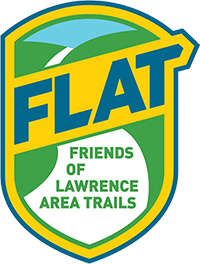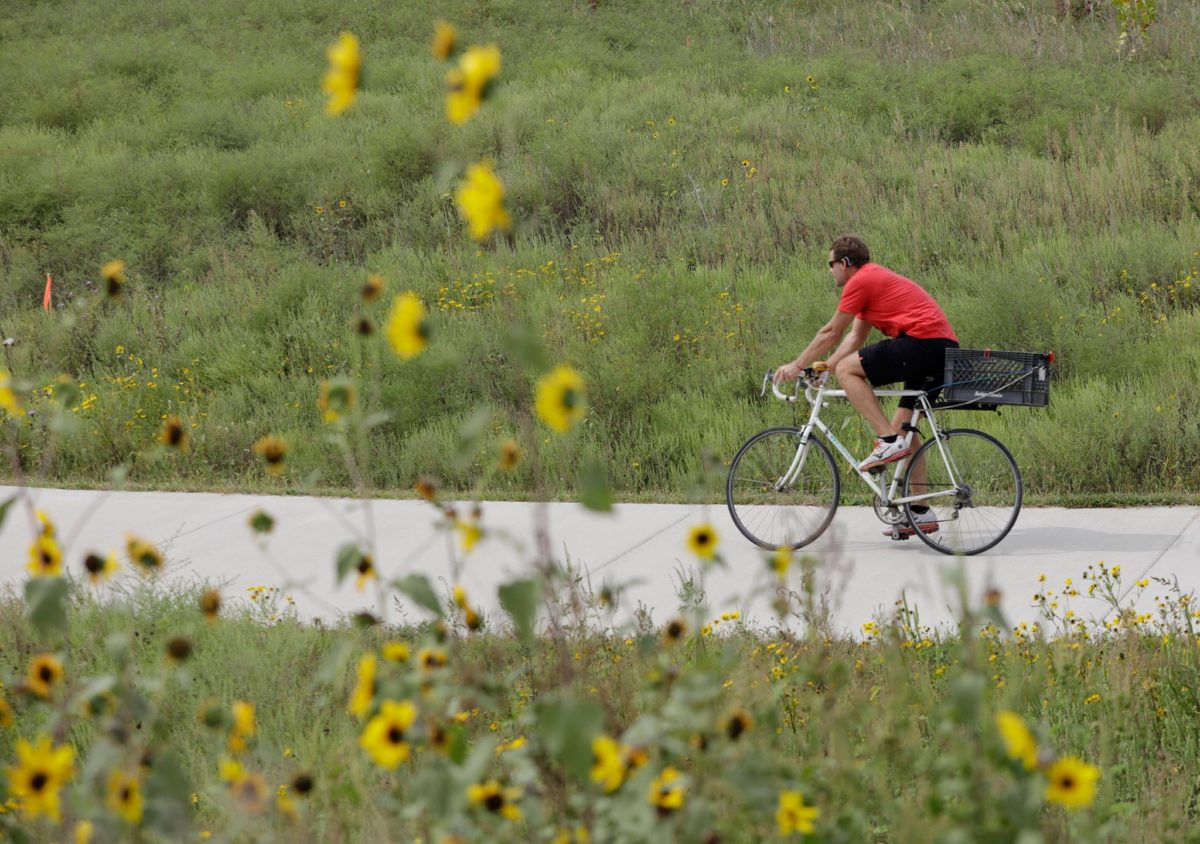Lawrence Loop = Green Eco-Machine
By Suzan Hampton, LEED AP bd+c, Urban Designer and FLAT board member
By Suzan Hampton, LEED AP bd+c, Urban Designer and FLAT board member
Your smile dims as up ahead, you see a slick of thick black mud covering the trail. Pools of water soak the grass on both sides and wash over the street where cars have slowed to a crawl. As you walk your bike around the mud and through traffic, you spot a raccoon that was hit by a car, probably during the night. The smile on your face disappears.
The huge recreational and health benefits of getting outdoors on trails like the Lawrence Loop are well understood. But as beneficial as trails are for us humans, they can play an equally important role for the environment.
Nationwide, cities are building trail systems and urban greenways that do double-duty as working landscapes. Also called green infrastructure, the native landscaping next to trails improves water and air quality, increases climate resilience, and protects wildlife while also providing us with all the great things we humans enjoy while we’re out on the trails.
How does a trail like the Lawrence Loop morph into a Green Eco-Machine? The key is the smart design of the landscape surrounding the trail.
By restoring native prairie plantings along the Loop, stormwater runoff from streets, parking lots, and buildings is slowed down, retained in the soil, and naturally treated by the plants’ deep root systems. This phytoremediation cleans water-born pollutants such as gasoline, pesticides, and even Fido’s poop from the water before it enters the Kaw Valley watershed. Native prairie plants also treat the excess nitrogen in agricultural runoff to reduce those algae problems we’re seeing in our lakes and streams.
Flooding on city streets is also reduced because native plants help the soil retain more moisture. Prairie grass roots can extend 15’ below the surface and break up compacted soils. This creates underground channels for stormwater to infiltrate into the water table instead of pooling up at the intersection.
We’re already seeing the effects of climate change locally with more frequent storms that release a higher volume of water in a shorter period of time. The average temperature is climbing upward, too. Green infrastructure helps counter these effects by managing excess water volume and velocity, and by reducing the heat island effect near parking lots, streets, and buildings.
Wildlife habitat is also improved by trails that employ green infrastructure. Native plants provide food and shelter for insects, birds, and mammals and these in turn become food for larger critters up the food chain. Flowering natives like milkweed are food for monarch butterfly larvae, and fruits and seeds attract rodents, which attract bald eagles and migratory birds. And connecting up parks and wetlands with “green trails” and bike/ped underpasses (like the one at 31st and Louisiana Street) creates safe travel corridors for our furry friends to move between habitats.
Finally, back to us humans! Green infrastructure can reduce city infrastructure costs (read: our taxes!) and promote economic growth since urban nature and trails are in high demand by active seniors and millennials looking to relocate to places like Lawrence. Vegetation and native trees planted alongside trails help us enjoy our outdoor experience by providing shade and beauty, and by cooling and cleaning the air. Native plantings reduce noise and offer views of nature, too: both proven mechanisms to reduce stress.
By restoring native prairie landscapes along the Lawrence Loop and planting natives as we build out our future trails, we’ll be helping each other AND the environment. Let’s turn on the Loop Green Eco-Machine!
Look here for more information on green infrastructure:
1. What is Green Infrastructure?
https://www.epa.gov/green-infrastructure/what-green-infrastructure
2. Stormwater Pollution & Green Infrastructure Solutions (video, green infrastructure segment at 15:20)
3. Stormwater Management: The Basics (video)
4. Restoration with Native Plants (video)
5. EPA Environmental Education – Role of Plants in Water Filtration (hands-on experiment, grades 4-7) https://www3.epa.gov/safewater/kids/pdfs/activity_grades_4-8_plantsinwaterfiltration.pdf
Photos:
Prairie Trail South, Illinois
Konza Prairie Trail, Kansas
Prairie Bike Trail, McHenry County, Illinois

